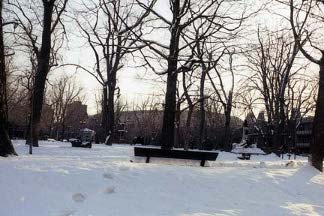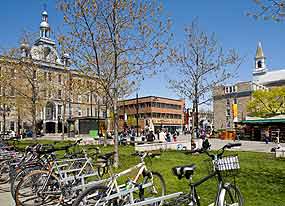|
Montreal DistrictsPlateau Mont-RoyalIn 1909, the Plateau Mont-Royal received its official name. Four villages are at the origin of this large Montreal borough now called Le Plateau. One of the four villages was once located on a territory now occupied by the Parc Laurier in the Petit-Plateau. In 1860, a tannery was located at the corner of Mont-Royal and Henri-Julien. As early as 1909, the beautiful town hall corner of Laurier and Saint-Laurent dominated the territory. Around 1900, the north of Duluth was an open country, but, as early as 1830 the wealthy Montrealers lived on Cherrier and in its surroundings.
The multiethnic presence influenced the architecture and the shops on Saint-Laurent and Mont-Royal created the most cosmopolitan area of Montreal. The signatures of a mixed presence can still be found on some of the Plateau's main streets and in some of its small parks. With its pavements and charming miniature parks arranged according to the traditions of many countries of the world, the Plateau Mont-Royal also shields an interesting number of patrimonial buildings. Among those splendours let's mention the Monastère des Pères du Très-Saint-Sacrement, the Hôtel-Dieu de Montréal and the Musée des Hospitalières de l'Hôtel-Dieu de Montréal, the Église de l’Immaculée Conception... the list is quite long. The newcomers established themselves on both sides of Saint-Laurent, first in the Quartier Saint-Louis and then in the Mile End. They worked in the clothing industry or opened small convenient shops. They were Polish, Russian, Ukrainian, Greek, German, Lithuanian and Jews. Half a century later, the Portuguese came and also marked their surroundings.  The economic crisis of the 1920’s, as well as a massive immigration of rural communities looking for jobs, brought important changes to the Plateau Mont-Royal. Around 1930, the Plateau was fully developed and mostly composed of workers. In 1940, the population started to decrease. Industries were being built in other parts of the city and the workers followed. In the 1960’s, the decrease in population was accentuated when a great number of families moved towards the suburbs. In the 1970’s, artists and craftsmen invaded the Plateau and created a whole new and different cultural environment. In the 1980’s, the artists were followed by professionals who were eager to secure themselves with a good quality life. They launched an important domiciliary restoration, limited transportation in the adjoining streets and preserved the local parks. The phenomenon created a different socio-economic profile. In the 1990’s bistros, fancy bars, smart restaurants and designer shops flourished on the traditional commercial roads like Saint-Laurent and Mont-Royal. The trendy ambience of today was starting to emerge. The Avenue du Mont-Royal, one of the main streets of the Plateau, is a dream place for shopping. It‘s an avenue where the highest concentration of original shops can be found. As for the side streets, they offer a soft atmosphere of peace and quiet. Whatever you are looking for, you are sure to find it on Mont-Royal Avenue. The area also conceals many municipal parks, including the Lafontaine Park where quite a large number of activities can be practiced throughout the year. The Plateau, with its artists, professionals and working-class families has been described as the best example of the way Montrealers live their life today. According to American magazines, the Plateau is one of the four most interesting “quartiers branchés” in North America. It is said that many Montrealers dream of settling down in this popular area. The district has indeed experienced an incredible rise in the value of its houses and condos and affordable decent apartments are now hard to find. Thank you for visiting Plateau Mont-Royal. Mile-End Exit Plateau Mont-Royal
|
Montreal Districts
What district am I in?
Ahuntsic
Anjou
Cartierville
Côte-des-Neiges
Hochelaga-Maisonneuve
Île Bizard
Lachine
LaSalle
Mercier
Montréal-Nord
Notre-Dame-de-Grâce
Outremont
Parc-Extension
Petite-Patrie
Pierrefonds
Plateau-Mont-Royal
Pointe-aux-Trembles
Rivière-des-Prairies
Rosemont
Roxboro
Sainte-Geneviève
Saint-Laurent
Saint-Léonard
Saint-Michel
Sud-Ouest
Verdun
Ville-Marie
Villeray
Atlas de l'emploi
Images Montréal
Images Montreal is a huge project that aims to be the biggest exclusive website of Montreal's skyscrapers, historical buildings and architecture landmarks.
Old historical monuments have a lot of interest as much as new apartment buildings, new skyscrapers or graffitis.
Montreal by Metro
Montreal by Metro is an unofficial website for fans of Montreal's metro system.
Our modern rapid transit system is one of the most architecturally distinctive subway systems in the world.
Unlike many other subway networks, every station in Montreal is distinct.
The system is beautifully decorated with hundreds of pieces of public art, including sculptures, frescoes, and stained glass.
STM Montréal
STM Montreal is composed of 68 metro stations spread along four lines and of a network made of 170 daytime and 20 night time bus service routes.
The metro provides 1.3 million trips every day. STM Montreal web site also offers a section called Art in the Métro.







